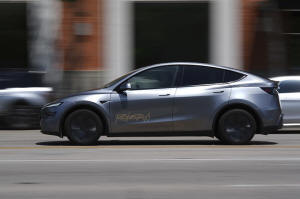Musk's 'robotaxis' draw regulatory scrutiny after video shows one
driving in an opposing lane
[June 25, 2025] By
BERNARD CONDON
Federal traffic safety regulators are looking into suspected problems
with Elon Musk's test run of self-driving “robotaxis” in Texas after
videos surfaced showing them braking suddenly or going straight through
an intersection from a turning lane and driving down the wrong side of
the road.
The National Highway Traffic Safety Administration said Tuesday that it
has asked Tesla for information about the apparent errors. Though many
other videos show robotaxis driving perfectly, if regulators find any
major issues, that would likely raise questions about Musk's repeated
statements that the robotaxis are safe and his claim that Tesla will
dominate a future in which nearly all cars on road will have no one
behind the wheel — or even need a steering wheel at all.
“NHTSA is aware of the referenced incidents and is in contact with the
manufacturer to gather additional information,” the agency said in a
statement.
Passengers in Tesla robotaxis on the road in Austin, Texas, have
generally been impressed, and the stock rose 8% Monday. Investors grew
more cautious Tuesday after news of NHTSA's inquiry, and the stock fell
more than 2%.
Tesla did not immediately respond to a request for comment.
A bullish Tesla financial analyst who was driven around in a robotaxi on
Sunday when the test runs began said his ride was perfect and suggested
the videos on X and YouTube showing errors were no big deal.
“Any issues they encounter will be fixed,” said Wedbush Securities' Dan
Ives, calling the test a “huge success" in the past three days “despite
the skeptics.”

One of those skeptics, a Telemetry Insight expert in car technology,
said the videos were alarming enough that the tests as currently run
should be halted.
“The system has always had highly erratic performance, working really
well a lot of the time but frequently making random and inconsistent but
dangerous errors," said Sam Abuelsamid in a text, referring to Tesla's
self-driving software. “This is not a system that should be carrying
members of the public or being tested on public roads without trained
test drivers behind the wheel.”
In one video, a Tesla moves into a lane with a big yellow arrow
indicating it is for left turns only but then goes straight through the
intersection instead, entering an opposing lane on the other side. The
car seems to realize it made some mistake and begins to swerve several
times, with the steering wheel jerking back and forth, before eventually
settling down.
[to top of second column] |

A driverless Tesla robotaxi, a ride-booking service, moves through
traffic, Sunday, June 22, 2025, in Austin, Texas. (AP Photo/Eric
Gay)
 But the Tesla proceeds in the
opposing lane for 10 seconds. At the time, there was no oncoming
traffic.
The passenger in the car who posted the video, money manager Rob
Maurer, shrugged off the incident.
“There are no vehicles anywhere in sight, so this wasn’t a safety
issue,” Maurer said in commentary accompanying his video. “I didn’t
feel uncomfortable in the situation.”
Another video shows a Tesla stopping twice suddenly in the middle of
the road, possibly responding to the flashing lights of police cars.
But the police are obviously not interested in the Tesla or traffic
in front or behind it because they have parked on side roads not
near it, apparently responding to an unrelated event.
Federal regulators opened an investigation last year into how Teslas
with what Musk calls Full Self-Driving have responded in
low-visibility conditions after several accidents, including one
that was fatal. Tesla was forced a recall 2.4 million of its
vehicles at the time.
Musk has said his Teslas using Full Self-Driving are safer than
human drivers and his robotaxis using a newer, improved version of
the system will be so successful so quickly that he will be able to
deploy hundreds of thousands of them on the road by the end of next
year.
Even if the Austin test goes well, though, the billionaire faces big
challenges. Other self-driving companies have launched taxis,
including Amazon's Zoox and current market leader Waymo, which is
not only is picking up passengers in Austin, but several other
cities. The company recently announced it had clocked its 10
millionth paid ride.
Musk needs a win in robotaxis. His work on in Trump administration
as cost-cutting czar has alienated many buyers among Tesla's
traditional environmentally conscious and liberal base in the U.S.,
tanking sales. Buyers in Europe having balked, too, after Musk
embraced some extreme right-wing politicians earlier this year in
both Britain and Germany.
All contents © copyright 2025 Associated Press. All rights reserved |